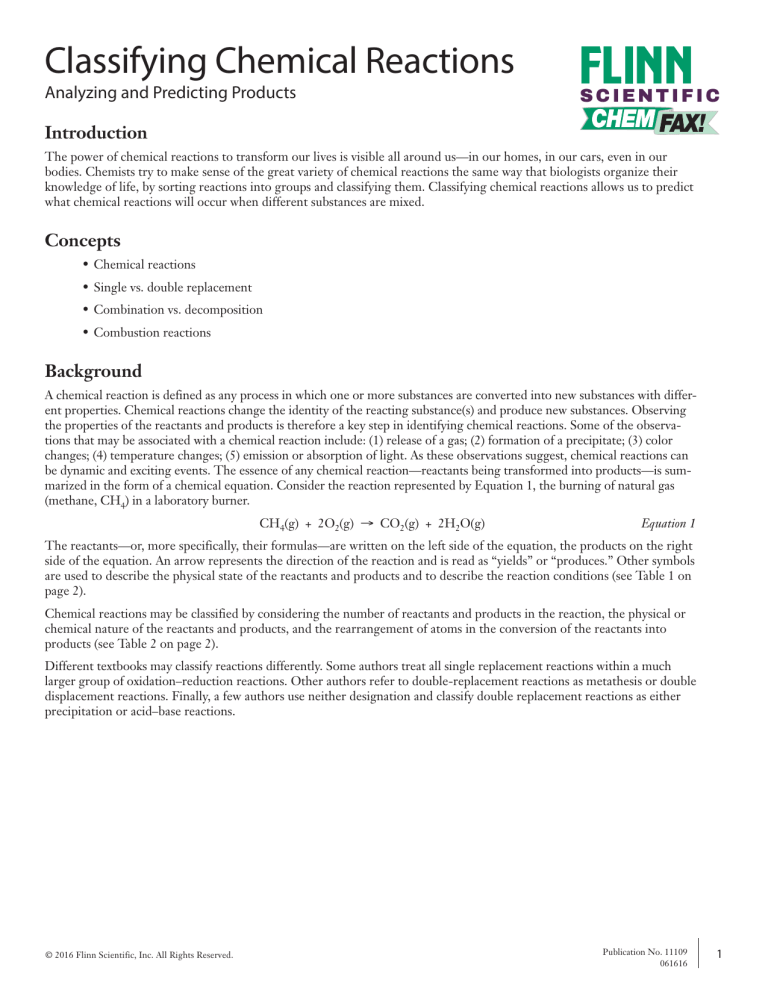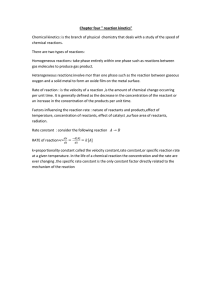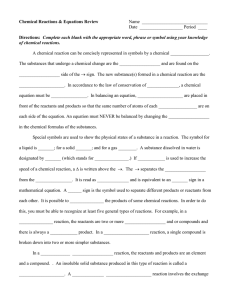
Classifying Chemical Reactions Analyzing and Predicting Products SCIENTIFIC Introduction The power of chemical reactions to transform our lives is visible all around us—in our homes, in our cars, even in our bodies. Chemists try to make sense of the great variety of chemical reactions the same way that biologists organize their knowledge of life, by sorting reactions into groups and classifying them. Classifying chemical reactions allows us to predict what chemical reactions will occur when different substances are mixed. Concepts • Chemical reactions • Single vs. double replacement • Combination vs. decomposition • Combustion reactions Background A chemical reaction is defined as any process in which one or more substances are converted into new substances with different properties. Chemical reactions change the identity of the reacting substance(s) and produce new substances. Observing the properties of the reactants and products is therefore a key step in identifying chemical reactions. Some of the observations that may be associated with a chemical reaction include: (1) release of a gas; (2) formation of a precipitate; (3) color changes; (4) temperature changes; (5) emission or absorption of light. As these observations suggest, chemical reactions can be dynamic and exciting events. The essence of any chemical reaction—reactants being transformed into products—is summarized in the form of a chemical equation. Consider the reaction represented by Equation 1, the burning of natural gas (methane, CH4) in a laboratory burner. CH4(g) + 2O2(g) → CO2(g) + 2H2O(g) Equation 1 The reactants—or, more specifically, their formulas—are written on the left side of the equation, the products on the right side of the equation. An arrow represents the direction of the reaction and is read as “yields” or “produces.” Other symbols are used to describe the physical state of the reactants and products and to describe the reaction conditions (see Table 1 on page 2). Chemical reactions may be classified by considering the number of reactants and products in the reaction, the physical or chemical nature of the reactants and products, and the rearrangement of atoms in the conversion of the reactants into products (see Table 2 on page 2). Different textbooks may classify reactions differently. Some authors treat all single replacement reactions within a much larger group of oxidation–reduction reactions. Other authors refer to double-replacement reactions as metathesis or double displacement reactions. Finally, a few authors use neither designation and classify double replacement reactions as either precipitation or acid–base reactions. © 2016 Flinn Scientific, Inc. All Rights Reserved. Publication No. 11109 061616 1 Classifying Chemical Reactions continued Table 1. Symbols in Chemical Equations Symbol Translation → Yields or produces (separates reactants from products) + Reacts with or forms alongside (separates two or more reactants or products) ∆ Reaction mixture is heated (written over the arrow) NR No reaction takes place when reactants are mixed (s) Pure substance (reactant or product) is a solid (l) Pure substance (reactant or product) is a liquid (g) Pure substance (reactant or product) is a gas (aq) Cat → Aqueous solution (reactant or product is dissolved in water) Catalyst—a substance needed to initiate a reaction (formula is written over the arrow) Table 2. Classification of Chemical Reactions Type of Reaction General Description and Example(s) Combination Two reactants combine to form a single product. The reactants may be elements or compounds. Also called a synthesis reaction. Zn(s) + I2(s) → ZnI2(s) CaO(s) + H2O(l) → Ca(OH)2(s) Decomposition One reactant, a compound, breaks down to give two or more products. 2H2O2(aq) → 2H2O(l) + O2(g) Single Replacement An element reacts with a compound and replaces one of the elements in the compound. Metals replace hydrogen or other metals; nonmetals replace nonmetals. Zn(s) + 2HCl(aq) → H2(g) + ZnCl2(aq) Cu(s) + 2AgNO3(aq) → 2Ag(s) + Cu(NO3)2(aq) Cl2(aq) + 2NaI(aq) → I2(aq) + 2NaCl(aq) Double Replacement Two ionic compounds (or compounds that break apart to form ions in solution) exchange ions to form new compounds. Examples include precipitation reactions (driving force is formation of a precipitate), acid–base reactions (driving force is formation of water), and gas-forming reactions (driving force is evolution of a gas). NaCl(aq) + AgNO3(aq) → AgCl(s) + NaNO3(aq) H2SO4(aq) + 2NaOH(aq) → Na2SO4(aq) + 2H2O(l) Na2SO3(aq) + 2HCl(aq) → 2NaCl(aq) + H2O(l) + SO2(g) Combustion A compound burns in the presence of oxygen, producing energy in the form of heat and light. The combustion of organic compounds produces carbon dioxide and water. C4H8(l) + 6O2(g) → 4CO2(g) + 4H2O(g) Reference This publication was adapted from Chemical Reactions, Flinn ChemTopic™ Labs, Volume 6; Cesa, I. Editor. Flinn Scientific, Inc.; Batavia, IL 2004 Flinn ChemTopic™ Lab manuals are available from Flinn Scientific, Inc. 2 © 2016 Flinn Scientific, Inc. All Rights Reserved.





